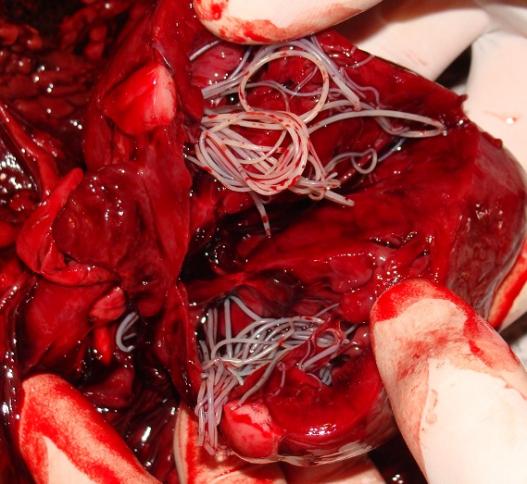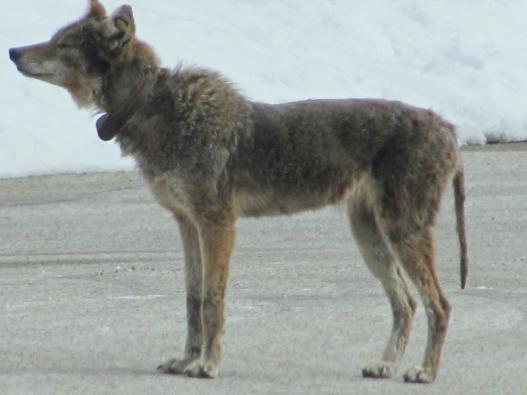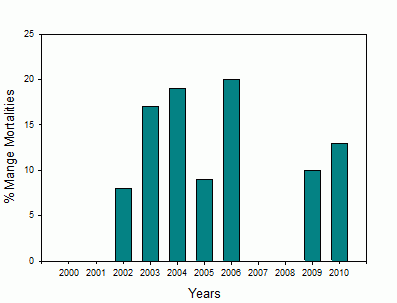Wildlife disease is of great importance to the health and safety of humans and domestic animals because 73% of emerging and reemerging pathogens are known to be zoonotic (transmitted from animals to people). There is increasing evidence suggesting that urbanization and resultant land-use changes contribute to the emergence of wildlife diseases through multiple mechanisms, with consequences for human and pet health. In light of the increasingly close association between wildlife and humans in Cook County, surveillance and proactive research is needed to guide and interlink human health and wildlife management programs with the goal of limiting the risk of human exposure to zoonotic diseases. Understanding the mechanisms of these diseases is equally critical.
Disease Monitoring Among Coyotes in Cook County
Through serological testing (using blood to identify disease), the Cook County Coyote Project looks primarily for the presence of these diseases in the coyote population: canine parvo, canine distemper, toxoplasmosis, Lyme, and Leptospirosis. These diseases are important to study because they can affect people or pets. While these diseases may occur in fairly high rates in coyotes, they are rarely transmitted to people or pets because of low pathogen survival rates in the environment or because the coyote may be a "dead-end" host. In some cases, positive results from serology may only serve to indicate exposure to a disease, and other diseases have multiple forms of which only some are zoonotic. It is important to note that by effectively vaccinating your pets against certain diseases, you are helping to break transmission potentials before they start; your pet's risk to diseases carried by wildlife populations in fact can be a direct result of proper domestic animal management.
Sometimes the diseases listed here are monitored not because coyotes host, transmit, or perpetuate them, but rather because coyotes are an excellent surveillance species that can provide information regarding general pathogens in the environment. Coyotes may even help mitigate certain diseases, like Lyme, by keeping rodent populations down and diversity up. Below is a look at some other familiar diseases being monitored.
Heartworm

Heartworms in a coyote heart (this animal died after being struck by a vehicle, not from this infection)
In rural areas, coyotes serve as a host for canine heartworm, an important parasite for domestic and wild canids (dogs and their relatives), and to a lesser extent other domestic animals and even humans. Canine heartworm is a filarial nematode (worm) with a six month life cycle that requires both mosquitoes and canid hosts. The adult worm is large and resides in the cardiopulmonary vasculature of the infected canine host. The severity of the infection depends on the number of worms and the length of infection. The parasite is transmitted from an infected canine to an uninfected canine via a mosquito vector. Once infected, the ambient temperature of the mosquito dictates the development of the larval stage; development only occurs above a threshold temperature, which becomes the heartworm transmission season. There is actually a limited number of days where the environment is suitable for the transmission to happen.
Whereas a number of studies have described the coyote-heartworm relationship for rural populations, little information is available for metropolitan areas and sample sizes were limited. As the number of coyotes in the urban areas continue to increase, it is possible that prevalence of the heartworm may also change. Therefore, heartworm in coyotes has been tested within Cook County continuously. Necropsies (postmortem examinations) of deceased coyotes showed a 41% infection rate of heartworm, which was approximately 10 times greater than coyotes from rural areas in northern Illinois.
Mange

Coyote with mange (this coyote, 571, survived her mange infection)
There are different types of mange with a range of severity among wildlife species. Scarcoptic mange is a debilitating disease associated with coyotes and their relatives, especially foxes, and is identified by dermatological examination. It is transmitted by a mite that infects an individual by burrowing into their skin. Extreme infection often follows: the animals typically lose most of their hair, become susceptible to other infections, or often succumb to exposure. In urban areas, coyotes likely serve as the host for this pathogen, which can spread to pets and, rarely, people. Direct exposure to an infected animal is necessary which is why risk of transmission is low. The research team has been monitoring mange in the Cook County coyote population since the project began in 2000. Initially, no mange was observed in the county but that changed in 2002, and mange has been maintained at low levels in most years. Data has shown mange to be the most common disease-related mortality in this area, made worse by harsh winters.

Frequency of mange-related coyote mortalities in Cook County by year
In areas where the disease is common, mange has contributed to human-coyote conflicts. Study results have revealed that coyotes with extensive mange infections are not aggressive (we have yet to record a pet attack by a mange-infected coyote). However, they may become more active during the day and often seek food or cover near houses, thereby increasing observations by the public. While animals with mange are difficult to witness given their poor state, animals can recover from the disease. It is best to leave the animals as they are; offering support by feeding infected individuals will only create more issues for those animals. Please see the story about coyote 571 to understand her bout with mange.
Rabies
Coyote-strain rabies is restricted to southern Texas but coyotes are sometimes infected with rabies from other species. In the Chicago area, there have been no cases of rabid coyotes. If a person is bitten by a coyote that is acting aggressive, he or she may be treated for rabies as a precaution. Anytime a person or pet is bitten by an animal, both animal care and human health professionals should be contacted.
